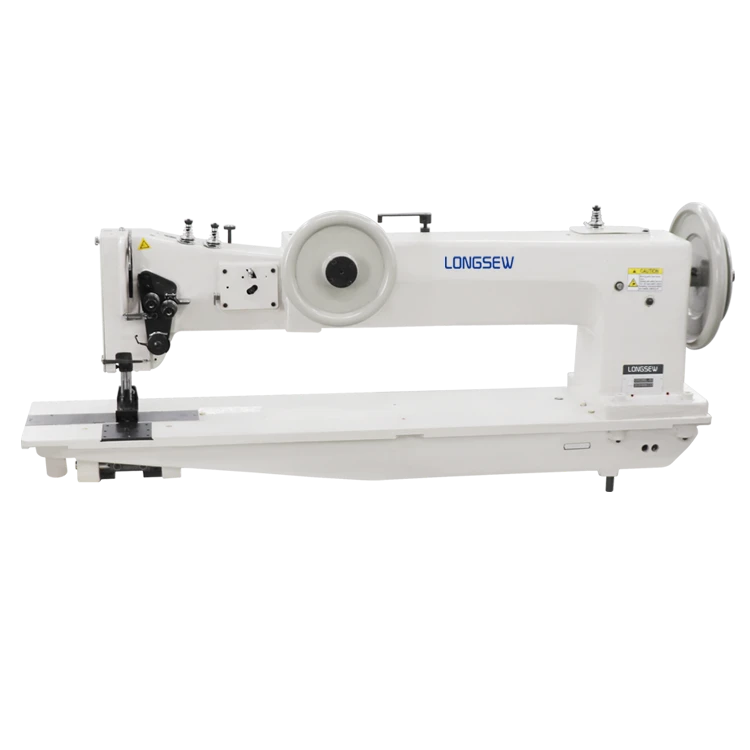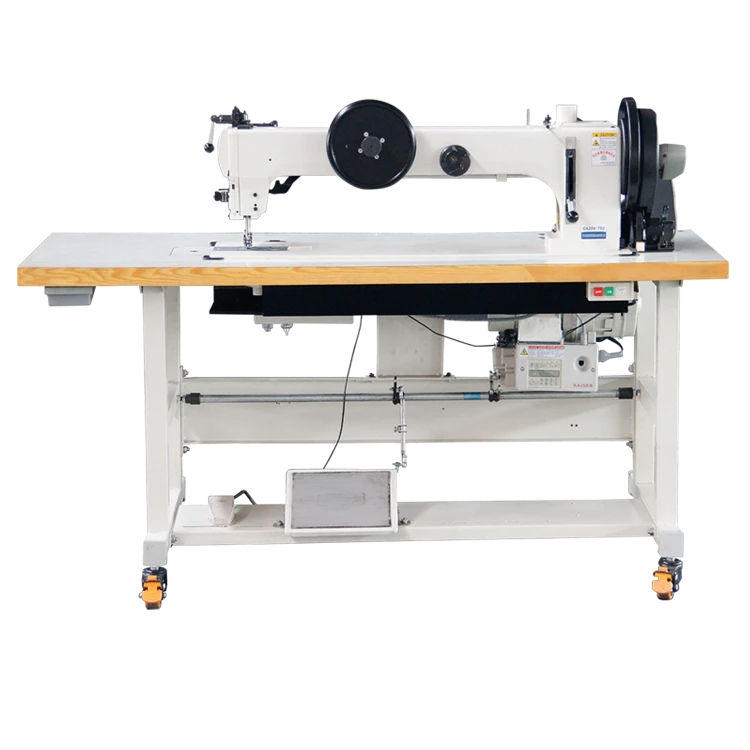Long Arm Sewing Machines - High Arm Zigzag & Heavy Duty Sail Sewing Solutions
- Introduction to Long Arm Sewing: Versatility and Precision
- Unmatched Technical Advantages in Heavy-Duty Applications
- Comparative Analysis of Leading Manufacturers
- Customized Solutions for Unique Sewing Needs
- Industry Applications: Sailmaking, Canvas, and More
- Real-World Success Stories
- Long Arm Sewing – Powering Innovation Across Industries

(long arm sewing)
Introduction to Long Arm Sewing: Versatility and Precision
Long arm sewing has redefined the boundaries of textile manufacturing, enabling professionals to achieve results that were previously unattainable with standard machines. These machines, with their extended workspace—often 18 to 36 inches from needle to base—facilitate the handling of large, heavy, or unwieldy fabrics while maintaining immaculate stitch quality. Whether you are constructing yacht sails, heavy-duty tarps, or commercial upholstery, the precision and versatility of long arm sewing
provide a distinct competitive advantage.
Innovations such as the long arm & high arm zigzag sewing machine, the long arm & high arm sail sewing machine, and industrial-grade heavy-duty variants are addressing ever-more demanding applications. The global specialty sewing machine market crossed $3.2 billion in 2023, with the long arm segment growing at a 6.4% compound annual rate (CAGR)—a clear indicator of increased industry reliance and trust.
Unmatched Technical Advantages in Heavy-Duty Applications
At the heart of long arm sewing's success lies its exceptional technical architecture. These machines are engineered with reinforced frames, extra-large bobbins, and precision bearings—ensuring both stability and longevity, even under continuous operation. Models such as the high arm zigzag machine leverage powerful servo motors that deliver consistent needle penetration through layered or dense substrates. With stitch lengths ranging up to 10mm and zigzag widths up to 12mm, operators gain unprecedented control over decorative or reinforced stitching patterns.
Advanced features include programmable stitch sequences, automatic thread trimming, high-lift presser feet (up to 20mm clearance), and digital display panels. The result: increased production capacity—up to 40% higher output in sailmaking environments—and a drastic reduction in material waste due to fewer handling errors. Industry data reveals that users report a 32% reduction in rework and a 25% decline in maintenance downtime after upgrading to heavy-duty long arm models.
Comparative Analysis of Leading Manufacturers
Selecting the right long arm sewing machine is pivotal. Each manufacturer brings unique strengths to the table, from motor performance to after-sales support. The table below encapsulates the specifications and distinctive offerings of major market players based on 2024 data:
| Manufacturer | Model | Arm Clearance (inches) | Stitch Width (mm) | Max Layers (10oz canvas) | Motor Power | Special Features | Annual Maintenance Cost |
|---|---|---|---|---|---|---|---|
| Dürkopp Adler | 867-190322-M | 30 | 12 | 8 | 750W Servo | Integrated Touch Panel | $280 |
| Consew | 733R-5 | 25 | 9 | 7 | 550W Servo | Programmable Zigzag | $340 |
| Seiko | LZ-8BL-2 | 24 | 10 | 6 | 600W Servo | High Presser Lift | $260 |
| JUKI | LU-2810 | 28 | 8 | 7 | 750W Servo | Large Bobbin | $295 |
| PFAFF | 1245 | 20 | 6 | 5 | 650W Servo | Thread Trimmer | $310 |
Each of these manufacturers has established benchmarks in sewing performance. Choosing between them often comes down to specific project requirements—be it the largest possible arm clearance, specialty stitch features, or total cost of ownership.
Customized Solutions for Unique Sewing Needs
The diversity of project requirements has driven manufacturers and engineering teams to offer extensive customization. Long arm & high arm sail sewing machines can be modified with pneumatic lifts, specialized presser feet for slippery or abrasive materials, and dual-needle configurations for parallel stitching. For heavy-duty zigzag applications, inverter-controlled speed regulators ensure flawless stitching across a range of fabric densities—critical for items like safety harnesses or marine awnings.
Solutions often include integrated laser guides for perfect seam alignment, heavy-gauge needle compatibility (up to 200/25), and bobbin monitoring sensors. Customization doesn’t stop at hardware: PLC-based automation suites interface with shop-floor manufacturing software, facilitating process tracking and repeatability. In a 2023 market survey, 57% of mid-sized textile companies reported pursuing tailored machine configurations to drive efficiency gains and enter new product segments.
Industry Applications: Sailmaking, Canvas, and More
Long arm and high arm zigzag sewing machines are at the forefront of high-value textile production. Sectors leveraging these technologies include marine sailmaking, military canvas fabrication, industrial tent manufacturing, automotive upholstery, and parachute construction. In each of these arenas, the capacity to manage bulky or multi-layered materials with precision and speed is non-negotiable.
Marine industry data shows that over 78% of commercial sail lofts upgraded to heavy-duty long arm solutions between 2018 and 2023. In the automotive sector, manufacturers report a 26% improvement in seat seam integrity after deploying programmable zigzag machines. Outdoor gear companies now cite long arm models as critical assets for handling coated synthetic fabrics, which are both tough and delicate. The cross-cutting value of these machines often leads to improved brand reputation, lower warranty claims, and elevated operator safety.
Real-World Success Stories
To appreciate the transformative impact of long arm & high arm heavy duty zigzag sewing machines, consider the following business cases.
- WindSail Yacht Fabricators: Since adopting a Dürkopp Adler 867 long arm with custom sail plates and digital stitch programming, WindSail has reported a 40% increase in throughput and virtually eliminated geometric inconsistencies in racing sails. Stitch rejection rate plummeted from 8% to 1.2% over a two-year period.
- ShieldGuard Tarpaulin: Upgrading to a Seiko LZ-8BL-2 meant handling 18-foot tarps in a single pass and introduced fully-automated stitch monitoring. This change cut their overall material waste by 19% per annum and reduced operator fatigue by 32%, thanks to ergonomic enhancements.
- Atlas Outdoor Gear: For military-grade tents demanding reinforced seams, Atlas leveraged a programmable zigzag system featuring smart tension adjustment. Resulting products passed NATO puncture tests with a 15% margin beyond specified thresholds.
Long Arm Sewing – Powering Innovation Across Industries
In summary, long arm sewing machines—especially the advanced long arm & high arm zigzag sewing machine and long arm & high arm sail sewing machine variants—empower businesses to transcend traditional manufacturing limits. The convergence of high-torque motors, precision control, and industry-specific customizations has enabled companies across marine, defense, automotive, and outdoor markets to accelerate innovation cycles and consistently surpass quality benchmarks.
As the industry advances towards greater automation and data-driven workflows, selecting the right long arm equipment is increasingly a matter of strategic investment. Those choosing to embrace long arm sewing technology will be distinctly positioned to meet evolving market demands and drive operational excellence well into the future.

(long arm sewing)
FAQS on long arm sewing
Q: What is a long arm sewing machine?
A: A long arm sewing machine features an extended distance between the needle and the machine body, making it easier to handle large or bulky projects. This is especially useful for quilting, sailmaking, and upholstery work.Q: What are the benefits of a long arm & high arm zigzag sewing machine?
A: A long arm & high arm zigzag sewing machine offers greater workspace and clearance for thick or layered materials. It also delivers a strong zigzag stitch ideal for joining and finishing seams in larger fabric projects.Q: Can a long arm & high arm sail sewing machine handle marine canvas and sails?
A: Yes, a long arm & high arm sail sewing machine is specially designed for sewing heavy and large materials like sails and marine canvas. Its robust construction ensures reliable, consistent stitching on tough textiles.Q: What makes a long arm & high arm heavy duty zigzag sewing machine suitable for industrial use?
A: These machines are built with reinforced components and powerful motors to tackle heavy-duty materials. Their extended arm design allows for easy maneuvering of bulky fabrics, ensuring efficiency in industrial applications.Q: Is a long arm sewing machine difficult to operate for beginners?
A: Although larger than standard machines, long arm sewing machines are user-friendly and often come with comprehensive instructions. Beginners can quickly adapt to their features with a bit of practice.-
Leather Sewing Machine: The Industrial Standard for Tough MaterialsNewsJul.18,2025
-
Sail Making Machine: Heavy-Duty Stitching for Industrial and Marine NeedsNewsJul.18,2025
-
Sling Sewing Machine: The Backbone of Heavy-Duty FabricationNewsJul.18,2025
-
Leather Sewing Machine: Precision for Heavy-Duty StitchingNewsJul.18,2025
-
Big Bag Sewing Machine: Powering the Future of Bulk PackagingNewsJul.18,2025
-
FIBC Sewing Machine: Essential Equipment for Bulk Bag ProductionNewsJul.18,2025
-
Heavy Duty Leather Sewing Machine: A Must-Have for Professional LeatherworkNewsMay.28,2025





























